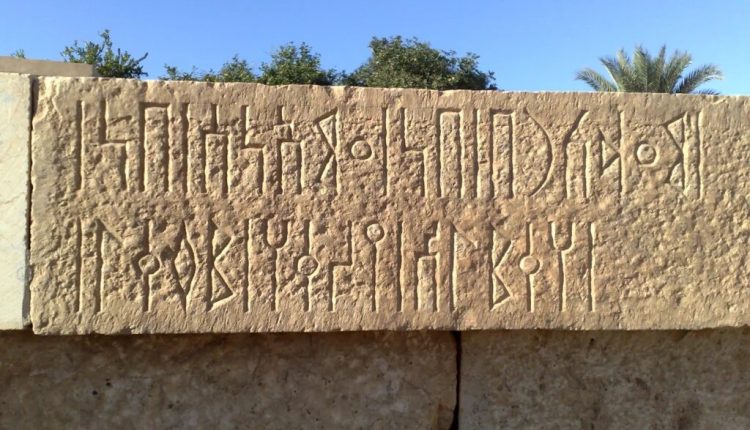Yemen’s Etched Memory: Musnad Script and Sabaean Inscriptions—A Journey into the Conscience of a Civilization Spoken in Stone
Deep within Yemeni history lie intellectual and cultural treasures still awaiting precise scientific exploration and broad analytical study—chief among them the Sabaean inscriptions and the Musnad script, which form a fundamental basis for understanding the cultural, political, and social life of the civilizations of South Arabia, foremost among them the Kingdom of Saba.
This report serves as a call to researchers, historians, and those interested in Yemeni and Arab cultural affairs to revisit this heritage, which has not yet received the attention it truly deserves, despite containing detailed documentary information about the region’s major historical transformations over thousands of years.
The report covers the historical background of the Musnad script and Sabaean inscriptions, the political, military, social, and religious themes they reflect, their cultural impact in shaping the civilizational identity of Yemen and the region, as well as the linguistic and historical significance of these inscriptions, and a call to revive them in the face of ongoing neglect.
Historical Background: Musnad Script and Sabaean Inscriptions
The Musnad script is one of the oldest scripts in the Arabian Peninsula, attributed to the ancient Yemeni civilizations, particularly the Kingdom of Saba. Its use has been documented since the first millennium BCE, and it was used in official inscriptions, religious texts, and economic transactions.
This script is distinguished by its independence from northern Semitic scripts such as Phoenician and Aramaic. It is one of the alphabetic scripts, sometimes written from right to left, and at other times from left to right (boustrophedon style), reflecting a complex and rich evolution of writing.
Sabaean Inscriptions: Stone Documents of Civilization
The Sabaean inscriptions are texts written in Musnad script, bearing political, religious, economic, and military signatures. These inscriptions have been found on rocks, temple walls, dam foundations, public buildings, statues, and altars, serving as the official records of that era.
These inscriptions accurately document tribal and political alliances, military campaigns and expeditions, infrastructure projects like the Marib Dam, religious beliefs and offerings, as well as the names and official titles of kings and rulers.
The Linguistic and Historical Significance of Sabaean Inscriptions
The Sabaean inscriptions written in Musnad script represent a unique linguistic and historical repository that contributes to reconstructing a deep understanding of the history of Arabia.
Linguistic Importance:
They demonstrate the evolution of South Arabian languages and their distinction from North Arabian Arabic, revealing rich linguistic structures and derivations. They also contribute to the understanding of the history of the Arabic alphabet, as the Musnad script represents an independent development from the Phoenician script, providing comparative linguistic data that aids in studying the evolution of phonetics and grammar, and the relationship between Musnad and both classical and Quranic Arabic.
Historical Importance:
The inscriptions serve as verified records of events, far removed from oral transmission, granting them precise historical value. They assist in tracing the chronology of kings and kingdoms, the emergence and dissolution of political powers in southern Arabia, and reveal the nature of society, systems of governance, and tribal and religious hierarchies. Additionally, they shed light on regional and international relations through references to trade and political ties with neighboring civilizations.
Documentary Content: Politics, Religion, and Society
The Sabaean inscriptions are marked by their official tone and exceptional documentary nature, revealing:
-
Political Structure: The inscriptions record the names of kings such as “Karib’il Watar” and “Shammar Yuhar’ish,” documenting systems of governance and internal and external alliances.
-
Military Campaigns: They describe invasions, the numbers of soldiers and weaponry, and field outcomes in detail rarely seen in other ancient Arabian inscriptions.
-
Construction and Development: They chronicle massive projects like the Marib Dam and clarify systems of irrigation and resource management.
-
Rituals and Beliefs: The inscriptions mention the names of deities and the offerings made, reflecting the depth of religiosity and organization within those societies.
Cultural and Civilizational Impact
The Musnad script reflects a distinct cultural identity for the civilizations of South Arabia and stands as evidence of early civilizational maturity in politics, language, and urban development. It contributes to the formation of an authentic Arab history based on internal, rather than foreign, sources.
The Reality of Neglect and the Need for Revival
Despite their immense significance, the inscriptions and Musnad script have remained neglected for decades due to a lack of specialized academic studies, weak digital and archaeological documentation, and their absence from educational curricula and cultural media discourse.
A Call for Re-examination
Reviving the study of Sabaean inscriptions is not a mere intellectual luxury, but a necessity to restore our cultural and historical identity and to strengthen our historical narrative through our original sources.
Conclusion
The Sabaean inscriptions and Musnad script form a unique intellectual and cultural treasure that should be at the forefront of Yemeni and Arab research and documentation efforts. They are not merely characters etched in stone, but civilizational testimonies to the rise of ancient Arab civilizations, pulsing with wisdom, depth, and sovereignty—worthy of being read with awareness, studied methodically, and preserved with reverence.

